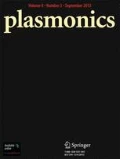Abstract
We report a simple method for preparation of plasmonic nanostructures containing two, three, four, and five closely spaced 15-nm gold particles. The structures were separated from each other and purified to greater than 90 % by electrophoresis. The plasmon absorption spectra of the structures are redshifted with respect to the spectrum of gold nanoparticles not connected to each other. The magnitude of the redshift is directly proportional to the number of nanoparticles in the structure.


References
Mirkin CA, Letsinger RL, Mucic RC, Storhoff JJ (1996) A DNA-based method for rationally assembling nanoparticles into macroscopic materials. Nature 382:607–609
Elghanian R, Storhoff JJ, Mucic RC, Letsinger RL, Mirkin CA (1997) Selective colorimetric detection of polynucleotides based on the distance-dependent optical properties of gold nanoparticles. Science 277:1078–1081
Leuvering JHW, Goverde BC, Thal PJHM, Schuurs AHWM (1983) A homogeneous sol particle immunoassay for human chorionic gonadotrophin using monoclonal antibodies. J Immunol Methods 60:9–23
Rosi NL, Mirkin CA (2005) Nanostructures in biodiagnostics. Chem Rev 105:1547–1562
Sujit Kumar Ghosh SK, Pal T (2007) Interparticle coupling effect on the surface plasmon resonance of gold nanoparticles: from theory to applications. Chem Rev 107:4797–4862
Khlebtsov NG, Dykman LA (2010) Optical properties and biomedical applications of plasmonic nanoparticles. J Quant Spectrosc Radiat Transf 111:1–35
Zanchet D, Micheel CM, Parak WJ, Gerion D, Williams SC, Alivisatos AP (2002) Electrophoretic and structural studies of DNA-directed Au nanoparticle groupings. J Phys Chem B 106:11758–11763
Claridge SA, Liang HW, Basu SR, Fréchet JMJ, Alivisatos AP (2008) Isolation of discrete nanoparticle—DNA conjugates for plasmonic applications. Nano Lett 8:1202–1206
Sheikholeslami S, Jun Y-W, Jain PK (2010) Coupling of optical resonances in a compositionally asymmetric plasmonic nanoparticle dimer. Nano Lett 10:2655–2660
Lubitz I, Kotlyar A (2011) G4-DNA-coated gold nanoparticles: synthesis and assembly. Bioconjug Chem 22:2043–2047
Novak JP, Feldheim DL (2000) Assembly of phenylacetylene-bridged silver and gold nanoparticle arrays. J Am Chem Soc 122(16):3979–3980. doi:10.1021/ja000477a
Wang Y, Chen G, Yang M, Silber G, Xing S, Tan LH, Wang F, Feng Y, Liu X, Li S, Chen H (2010) A systems approach towards the stoichiometry-controlled hetero-assembly of nanoparticles. Nat Commun 1:87–94
Chen G, Wang Y, Tan LH, Yang M, Tan LS, Chen Y, Chen H (2009) High-purity separation of gold nanoparticle dimers and trimers. J Am Chem Soc 131:4218–4219
Bidault S, Polman (2012) Water-based assembly and purification of plasmon-coupled gold nanoparticle dimers and trimers. International J of Optics ID 387274, 5p. doi:10.1155/2012/387274
Myroshnychenko V, Rodríguez-Fernández J, Pastoriza-Santos I, Funston AM, Novo C, Mulvaney P, Liz-Marzán LM, García de Abajo F (2008) Modelling the optical response of gold nanoparticles. J Chem Soc Rev 37:1792–1805
Kimling J, Maier M, Okenve B, Kotaidis V, Ballot H, Plech A (2006) Turkevich method for gold nanoparticle synthesis revisited. J Phys Chem B 110:15700–15707
Demers LM, Mirkin CA, Mucic RC, Reynolds RA, Letsinger RL, Elghanian R, Viswanadham AG (2000) A fluorescence-based method for determining the surface coverage and hybridization efficiency of thiol-capped oligonucleotides bound to gold thin films and nanoparticles. Anal Chem 72:5535–5541
Acknowledgments
This work was supported by the Israel Science Foundation, 172/10.
Conflict of interest
The authors declare no competing financial interests.
Author information
Authors and Affiliations
Corresponding author
Electronic Supplementary Material
Below is the link to the electronic supplementary material.
ESM 1
(DOC .99 mb)
Rights and permissions
About this article
Cite this article
Halamish, S., Eidelshtein, G. & Kotlyar, A. Plasmon-Coupled Nanostructures Comprising Finite Number of Gold Particles. Plasmonics 8, 745–748 (2013). https://doi.org/10.1007/s11468-012-9466-x
Received:
Accepted:
Published:
Issue Date:
DOI: https://doi.org/10.1007/s11468-012-9466-x

